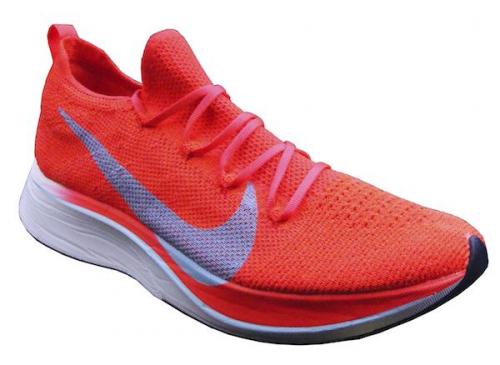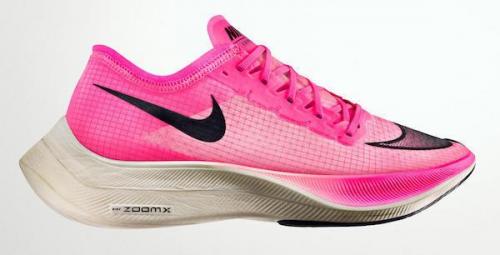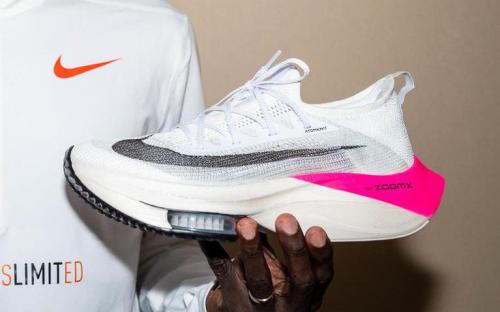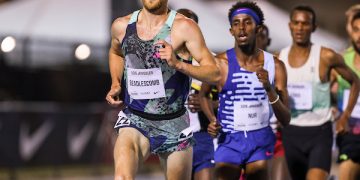 Nike Vaporfly Next 4%
Nike Vaporfly Next 4%
 Nike Zoom Next %
Nike Zoom Next %
 Eliud Kipchoge’s Nike AlphaFly prototype, photo: INEOS 159, found on Believeintherun.com
Eliud Kipchoge’s Nike AlphaFly prototype, photo: INEOS 159, found on Believeintherun.com
Original Post: November 13, 2019
Updated post: December 4, 2019
Special TRE 2019 Post:
How do local running stores feel about these special shoes? Why, they love them. If you are picked by Nike (top 20-50 store, based on volume), this is Christmas. Top local runners, aka the key influencers are buying this shoe, no matter the price. Nike is taking ASICS users away in droves, among the brands hurt by this shoe.
The controversy is raging. Can you have too much aid from a shoe? Should one company have nearly all new technology protected, and where does business and sport overlap?
And also, is the IAAF equipped to make such decisions, knowing that the brand they censure could be a potential next sponsor?
Cregg Weinmann has been the RN footwear editor since 1998, life long runner and a man who has spent nearly six decades using and examining running shoes. We asked Cregg to look at this controversy and shed some light onto the topic.
RunBlogRun: There is a large ruckus going on over the new Nike racing shoe, the Nike Vaporfly Next, please answer the following:
RunBlogRun, # 1. What makes the Nike shoe so special?
Cregg Weinmann : In short, the best midsole foam to date, and precisely shaped carbon fiber plates in the midsole.
This is at least the fifth iteration of a Nike running shoe with an oversized foam midsole, and a rigid plate, testament to considerable work and collaboration between talented and motivated people, including some of the very best athletes on the planet validating design strategies.
RunBlogRun, # 2. What is the difference between Eliud Kipchoge’s shoe and Brigid Kosgei’s shoes?
Cregg Weinmann : Brigid Kosgei’s world record was accomplished with the Vaporfly Next%, a shoe with a lighter upper than the original Vaporfly, and a few more millimeters of the Pebax foam.
Eliud Kipchoge ran in a shoe dubbed the AlphaFly, which blends concepts – at least philosophically, of a shoe from the 90’s, the Zoom Alpha, with the Vaporfly shoes which had already come to market. The AlphaFly has three key differences to the Next%. First, it has just a few more millimeters of Pebax foam which eases the shock and assists running efficiency. Second, it has two layers of Zoom Airbags to cushion the forefoot, separated by a carbon fiber plate top and bottom. Thirdly, and key to performance, is three carbon plates which surround the Airbags, and one which extends from heel to forefoot, similar to the single plate in the other Vaporfly shoes.
RunBlogRun, #3. Aren’t there other shoes that compare?
Cregg Weinmann : Comparable, though Nike has some proprietary differences, including the Pebax foam which to this point has not been incorporated by their competitors. Hoka One One, New Balance, Nike, and Skechers all have shoes with curved plates. Further, Saucony, Asics, and Brooks have athletes identified as being in similar prototype shoes. So there is a chase pack, rather than Nike being alone in the concept shoe department.
RunBlogRun, # 4. Last time IAAF or USATF banned a shoe? – Spira for USATF (2007) and PUMA’s brush spikes (1968)?
Cregg Weinmann : I recall an anecdote from one of the early US vs. USSR dual track meets from the 1960’s. The results from many of the competitions within the Soviet block were all but unknown as information was throttled by their government. The jumpers of the national team; long, triple and high jump made big improvements in part because of sports research, concentration on developing talent, and optimization of equipment, including footwear. High jumpers were wearing a shoe with a built up sole which prompted some to speculate that their jumpers must have had springs in their shoes to jump that well. This led to new rules regulating allowable limits.
In 1968, ahead of the Mexico City Olympics, Puma introduced a shoe with 68 permanent needle spikes in its plate. These were very thin and gripped the new Tartan synthetic surfaces more effectively than traditional spikes. Two world’s best’s were established. Protests from competitors weighed heavily on the IAAF’s decision to clarify the rules, and they currently limit the number of spikes to 11 (at latest count). The marks established in the Puma shoes were not ratified.
Spira is a small running shoe brand which utilizes a stainless steel spring in the heel and forefoot to attenuate shock during the running stride. While the IAAF rule 143.3(a) does not specifically exclude springs, the USATF rule states “3(a) …such as a spring or similar device.” as an addition, which resulted in the ban on the Spira shoes for competition in USATF events.
RunBlogRun, #5. What does IAAF rule state?
Cregg Weinmann : The current rule 143.3 states: “Athletes may compete barefoot or with footwear on one or both feet. The purpose of shoes for competition is to give protection and stability to the feet and a firm grip on the ground. Such shoes, however, must not be constructed so as to give an athlete any unfair additional assistance, including by the incorporation of any technology which will give the wearer any unfair advantage. A shoe strap over the instep is permitted. All types of competition shoes must be approved by IAAF.”
The last sentence speaks volumes, and there is a technical group which has been convened to study and recommend a solution to the specifics of a ruling. Stay tuned.
RunBlogRun, #6. What do you think of the shoe?
Cregg Weinmann : The oversized sole has become a go to feature for many runners, with the popularity of the Hoka One One shoes. The extra foam has reduced injury for many runners and was a survival strategy for many competitors in the back half of the Ironman and Marathon fields, for several years now. The original Vaporfly shoe has a unique feel, which produces results, especially for distances from the half marathon on up. The carbon plate and foam improve efficiency, so you get a best of both worlds effect – comfort and speed.
Can it shave 60-90 seconds off a performance?
Yes, though results may vary. Seven of the top ten times on the men’s all-time marathon list are attributable to the shoe, so there’s that.
RunBlogRun, #7: Someone accused Nike and others of using shoes like some use doping?
Cregg Weinmann : One difference with a doper and a competitor using a plated shoe is that the shoes look different than traditional racing flats, so it is obvious if you are using them. In light of recent events at Nike, some detractors have piled on, so to speak, with their own interpretations of a corporate attitude that appears to adopt the old adage “winning isn’t everything, it is the only thing.” Nike’s success as a brand has attracted both admirers and detractors, and many of each are vocal about their support, or lack thereof.
RunBlogRun, #8. Is shoe design the new doping?
Cregg Weinmann : Equipment will always attract those looking to adopt the gear to be the best they can be. The International Association of Athletics Federation has convened a panel to study the issues surrounding road racing shoes and plates. One dilemma is that they have already ratified world records made with the shoes, so the paradox of putting the Genie back into the bottle and disallowing those records would seem to suggest some other solution. The argument has been made to limit sole thickness, similar to that in Long Jump and High Jump shoes, which are already in the IAAF technical rules.
The last time the playing field was level for road racing shoes, was probably in the 1950s when all of the serious road racing flats were made out of leather. Even then, one notable exception was the ASICS Marathon Tabi, a canvas shoe with a separate slot for the big toe, which may have generated a tiny bit more force from the metatarsophalangeal (MTP) joint. One pivotal factor in the current debate, is that the plates affect energy in the MTP joint, and also at the ankle.
Shoes have always been a part of Athletics. In the 1960s, you began to see racing shoes with midsoles to give better protection and allow improvement in the toe-off, and as soon as you start shaping the midsoles you begin to improve the efficiencies of running in the shoes. The question then arises: How much is too much?
We have had athletic shoe industry disequilibrium before. In the 1960’s the introduction of nylon uppers, which made racing shoes lighter and more durable, gave ASICS and blue ribbon sports (Nike’s precursor) a temporary edge. More recently with midsole foam, first in the late 1970’s to early 1980’s as Ethylene Vinyl Acetate (EVA) and polyurethane (PU) replaced foamed rubber. Earlier this decade, thermoplastic urethane (TPU), shook up the industry and shoes from Adidas, Saucony, and Brooks utilized the foam. Now with Pebax we’ve seen a little hysteria, and a price to match ($250+), which perhaps only Nike could have easily pulled off. Many entering the debate now, seem to be unaware that chemical company Zotefoams was shopping the pricey Pebax foam to all-comers, at least five years ago.
Rapid prototyping and production has made it possible for very quick turnarounds in shoe design and manufacturing. Once the ideas became known, after shoes were released, then a certain level of adaptation and mimicry took place, and while there is a certain amount of individuality, the performance results are very similar. Though this does play well with the notion that the shoes be reasonably available to all competitors.
 Eliud Kipchoge’s Nike AlphaFly prototype, photo: INEOS 159, found on Believeintherun.com
Eliud Kipchoge’s Nike AlphaFly prototype, photo: INEOS 159, found on Believeintherun.com






















